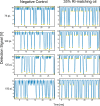Ultra-High-Throughput Absorbance-Activated Droplet Sorting for Enzyme Screening at Kilohertz Frequencies
- PMID: 36848587
- PMCID: PMC10018449
- DOI: 10.1021/acs.analchem.2c04144
Ultra-High-Throughput Absorbance-Activated Droplet Sorting for Enzyme Screening at Kilohertz Frequencies
Abstract
Droplet microfluidics is a valuable method to "beat the odds" in high throughput screening campaigns such as directed evolution, where valuable hits are infrequent and large library sizes are required. Absorbance-based sorting expands the range of enzyme families that can be subjected to droplet screening by expanding possible assays beyond fluorescence detection. However, absorbance-activated droplet sorting (AADS) is currently ∼10-fold slower than typical fluorescence-activated droplet sorting (FADS), meaning that, in comparison, a larger portion of sequence space is inaccessible due to throughput constraints. Here we improve AADS to reach kHz sorting speeds in an order of magnitude increase over previous designs, with close-to-ideal sorting accuracy. This is achieved by a combination of (i) the use of refractive index matching oil that improves signal quality by removal of side scattering (increasing the sensitivity of absorbance measurements); (ii) a sorting algorithm capable of sorting at this increased frequency with an Arduino Due; and (iii) a chip design that transmits product detection better into sorting decisions without false positives, namely a single-layered inlet to space droplets further apart and injections of "bias oil" providing a fluidic barrier preventing droplets from entering the incorrect sorting channel. The updated ultra-high-throughput absorbance-activated droplet sorter increases the effective sensitivity of absorbance measurements through better signal quality at a speed that matches the more established fluorescence-activated sorting devices.
Conflict of interest statement
The authors declare no competing financial interest.
Figures





Similar articles
-
Confocal Absorbance-Activated Droplet Sorting (cAADS) for Enzyme Engineering.Adv Sci (Weinh). 2025 Aug 14:e05324. doi: 10.1002/advs.202505324. Online ahead of print. Adv Sci (Weinh). 2025. PMID: 40810646
-
Ultrahigh-throughput-directed enzyme evolution by absorbance-activated droplet sorting (AADS).Proc Natl Acad Sci U S A. 2016 Nov 22;113(47):E7383-E7389. doi: 10.1073/pnas.1606927113. Epub 2016 Nov 7. Proc Natl Acad Sci U S A. 2016. PMID: 27821774 Free PMC article.
-
Mass Activated Droplet Sorting (MADS) Enables High-Throughput Screening of Enzymatic Reactions at Nanoliter Scale.Angew Chem Int Ed Engl. 2020 Mar 9;59(11):4470-4477. doi: 10.1002/anie.201913203. Epub 2020 Jan 28. Angew Chem Int Ed Engl. 2020. PMID: 31868984
-
Recent Advances on Sorting Methods of High-Throughput Droplet-Based Microfluidics in Enzyme Directed Evolution.Front Chem. 2021 Apr 23;9:666867. doi: 10.3389/fchem.2021.666867. eCollection 2021. Front Chem. 2021. PMID: 33996758 Free PMC article. Review.
-
Recent progress in high-throughput droplet screening and sorting for bioanalysis.Biosens Bioelectron. 2023 Apr 1;225:115107. doi: 10.1016/j.bios.2023.115107. Epub 2023 Jan 30. Biosens Bioelectron. 2023. PMID: 36731396 Review.
Cited by
-
Carbohydrate-active enzyme (CAZyme) discovery and engineering via (Ultra)high-throughput screening.RSC Chem Biol. 2024 May 23;5(7):595-616. doi: 10.1039/d4cb00024b. eCollection 2024 Jul 3. RSC Chem Biol. 2024. PMID: 38966674 Free PMC article. Review.
-
Fluorogenic, Subsingle-Turnover Monitoring of Enzymatic Reactions Involving NAD(P)H Provides a Generalized Platform for Directed Ultrahigh-Throughput Evolution of Biocatalysts in Microdroplets.J Am Chem Soc. 2025 Apr 2;147(13):10903-10915. doi: 10.1021/jacs.4c11804. Epub 2025 Mar 24. J Am Chem Soc. 2025. PMID: 40127491 Free PMC article.
-
Recent advances in droplet sequential monitoring methods for droplet sorting.Biomicrofluidics. 2023 Nov 13;17(6):061501. doi: 10.1063/5.0173340. eCollection 2023 Dec. Biomicrofluidics. 2023. PMID: 37969470 Free PMC article. Review.
-
Droplet Microfluidics for High-Throughput Screening and Directed Evolution of Biomolecules.Micromachines (Basel). 2024 Jul 29;15(8):971. doi: 10.3390/mi15080971. Micromachines (Basel). 2024. PMID: 39203623 Free PMC article. Review.
-
Continuous FACS Sorting of Double Emulsion Picoreactors with a 3D-Printed Vertical Mixer.Anal Chem. 2025 Jul 15;97(27):14406-14414. doi: 10.1021/acs.analchem.5c01536. Epub 2025 Jul 2. Anal Chem. 2025. PMID: 40602756 Free PMC article.
References
-
- Debon A.; Pott M.; Obexer R.; Green A. P.; Friedrich L.; Griffiths A. D.; Hilvert D. Ultrahigh-Throughput Screening Enables Efficient Single-Round Oxidase Remodelling. Nat. Catal 2019, 2 (9), 740–747. 10.1038/s41929-019-0340-5. - DOI
-
- Ma F.; Chung M. T.; Yao Y.; Nidetz R.; Lee L. M.; Liu A. P.; Feng Y.; Kurabayashi K.; Yang G.-Y. Efficient Molecular Evolution to Generate Enantioselective Enzymes Using a Dual-Channel Microfluidic Droplet Screening Platform. Nat. Commun. 2018, 9 (1), 1030.10.1038/s41467-018-03492-6. - DOI - PMC - PubMed
Publication types
MeSH terms
Grants and funding
LinkOut - more resources
Full Text Sources

